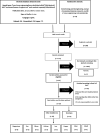Therapeutic Metallic Ions in Bone Tissue Engineering: A Systematic Review of The Literature
- PMID: 32802092
- PMCID: PMC7393040
- DOI: 10.22037/ijpr.2020.112641.13894
Therapeutic Metallic Ions in Bone Tissue Engineering: A Systematic Review of The Literature
Abstract
An important field of bone tissue engineering (BTE) concerns the design and fabrication of smart scaffolds capable of inducing cellular interactions and differentiation of osteo-progenitor cells. One of these additives that has gained growing attention is metallic ions as therapeutic agents (MITAs). The specific biological advantage that these ions bring to scaffolds as well as other potential mechanical, and antimicrobial enhancements may vary depending on the ion entity, fabrication method, and biomaterials used. Therefore, this article provides an overview on current status of In-vivo application of MITAs in BTE and the remaining challenges in the field. Electronic databases, including PubMed, Scopus, Science direct and Cochrane library were searched for studies on MITAs treatments for BTE. We searched for articles in English from January-2000 to October-2019. Abstracts, letters, conference papers and reviews, In-vitro studies, studies on alloys and studies investigating effects other than enhancement of new bone formation (NBF) were excluded. A detailed summary of relevant metallic ions with specific scaffold material and design, cell type, animal model and defect type, the implantation period, measured parameters and obtained qualitative and quantitative results is presented. No ideal material or fabrication method suited to deliver MITAs can yet be agreed upon, but an investigation into various systems and their drawbacks or potential advantages can lead the future research. A tendency to enhance NBF with MITAs can be observed in the studies. However, this needs to be validated with further studies comparing various ions with each other in the same animal model using critical-sized defects.
Keywords: Bone tissue engineering; Dug delivery; Metallic ions; Scaffolds; Therapeutic ions.
Figures


Similar articles
-
Regenerating bone with bioactive glass scaffolds: A review of in vivo studies in bone defect models.Acta Biomater. 2017 Oct 15;62:1-28. doi: 10.1016/j.actbio.2017.08.030. Epub 2017 Aug 24. Acta Biomater. 2017. PMID: 28844964 Review.
-
Current state of fabrication technologies and materials for bone tissue engineering.Acta Biomater. 2018 Oct 15;80:1-30. doi: 10.1016/j.actbio.2018.09.031. Epub 2018 Sep 22. Acta Biomater. 2018. PMID: 30248515 Review.
-
Composite polymer-bioceramic scaffolds with drug delivery capability for bone tissue engineering.Expert Opin Drug Deliv. 2013 Oct;10(10):1353-65. doi: 10.1517/17425247.2013.808183. Epub 2013 Jun 19. Expert Opin Drug Deliv. 2013. PMID: 23777443 Review.
-
Porous magnesium-based scaffolds for tissue engineering.Mater Sci Eng C Mater Biol Appl. 2017 Feb 1;71:1253-1266. doi: 10.1016/j.msec.2016.11.027. Epub 2016 Nov 9. Mater Sci Eng C Mater Biol Appl. 2017. PMID: 27987682 Review.
-
Three-dimensional (3D) printed scaffold and material selection for bone repair.Acta Biomater. 2019 Jan 15;84:16-33. doi: 10.1016/j.actbio.2018.11.039. Epub 2018 Nov 24. Acta Biomater. 2019. PMID: 30481607 Review.
Cited by
-
Controlled Sr(ii) ion release from in situ crosslinking electroactive hydrogels with potential for the treatment of infections.RSC Adv. 2024 Jan 31;14(7):4324-4334. doi: 10.1039/d3ra07061a. eCollection 2024 Jan 31. RSC Adv. 2024. PMID: 38304567 Free PMC article.
-
Biomimetic PLGA/Strontium-Zinc Nano Hydroxyapatite Composite Scaffolds for Bone Regeneration.J Funct Biomater. 2022 Jan 28;13(1):13. doi: 10.3390/jfb13010013. J Funct Biomater. 2022. PMID: 35225976 Free PMC article.
-
Rethinking Biomedical Titanium Alloy Design: A Review of Challenges from Biological and Manufacturing Perspectives.Adv Healthc Mater. 2025 Feb;14(4):e2403129. doi: 10.1002/adhm.202403129. Epub 2024 Dec 23. Adv Healthc Mater. 2025. PMID: 39711273 Free PMC article. Review.
-
Physicochemical and Biological Characterization of Gelatin/Alginate Scaffolds Reinforced with β-TCP, FDBA, and SrHA: Insights into Stem Cell Behavior and Osteogenic Differentiation.Int J Biomater. 2024 Aug 19;2024:1365080. doi: 10.1155/2024/1365080. eCollection 2024. Int J Biomater. 2024. PMID: 39376511 Free PMC article.
-
Ceramic Nanofiber Materials for Wound Healing and Bone Regeneration: A Brief Review.Materials (Basel). 2022 May 31;15(11):3909. doi: 10.3390/ma15113909. Materials (Basel). 2022. PMID: 35683207 Free PMC article. Review.
References
-
- Bostancioglu RB, Gurbuz M, Akyurekli AG, Dogan A, Koparal AS, Koparal AT. Adhesion profile and differentiation capacity of human adipose tissue derived mesenchymal stem cells grown on metal ion (Zn, Ag and Cu) doped hydroxyapatite nano-coated surfaces. Colloids Surf. B Biointerfaces . 2017;155:415–28. - PubMed
-
- Sánchez AHM, Omidi M, Wurlitzer M, Fuh MM, Feyerabend F, Schlüter H, Willumeit-Römer R, Luthringer B. Proteome analysis of human mesenchymal stem cells undergoing chondrogenesis when exposed to the products of various magnesium-based materials degradation. Bioactive Materials . 2019;4:168–88. - PMC - PubMed
Publication types
LinkOut - more resources
Full Text Sources
